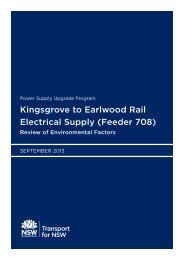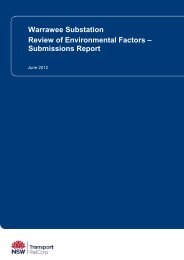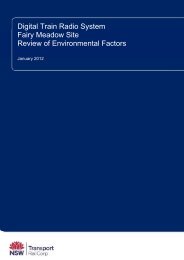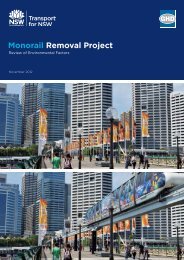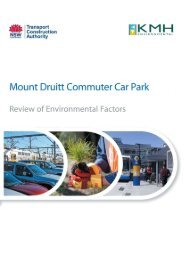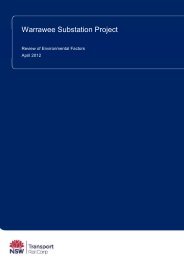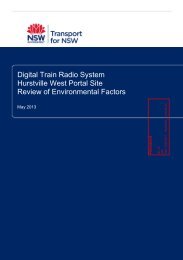Stanwell Park Tunnel REF - Transport for NSW - NSW Government
Stanwell Park Tunnel REF - Transport for NSW - NSW Government
Stanwell Park Tunnel REF - Transport for NSW - NSW Government
You also want an ePaper? Increase the reach of your titles
YUMPU automatically turns print PDFs into web optimized ePapers that Google loves.
Plant and equipment will be checked regularly <strong>for</strong> oil leaks.<br />
Plant and equipment will not be refuelled on site.<br />
Wash down areas will be located away from waterways and drainage lines.<br />
Liquid waste generated during non-destructive excavation will be removed from the-site <strong>for</strong><br />
treatment and disposal.<br />
4.3 Air Quality<br />
Existing Situation<br />
Wollongong City Council’s State of the Environment Annual Report 2011-2012 reported that the<br />
regional air quality in Wollongong was largely ‘good’. Local air quality is influenced by domestic<br />
and industrial emissions and prevailing weather conditions.<br />
Potential Impacts<br />
Local and regional air quality can be affected during construction by dust, construction vehicle<br />
emissions and odour. Dust may be generated from the disturbance of soils or poorly maintained<br />
stockpile areas, which can affect human health or property. Poorly maintained vehicles can<br />
produce excess emissions.<br />
The works will require energy to power vehicles (e.g. construction, delivery and staff vehicles)<br />
and construction plant. The energy requirements will primarily be in the <strong>for</strong>m of fuel (petrol and<br />
diesel). Fuel use will emit greenhouse gases with about 2.3 to 2.7 kilograms of carbon dioxide<br />
equivalent (CO 2 -e) per litre of fuel consumed (DEWHA 2008). In addition, indirect and third<br />
party emissions will be generated as a result of energy used to produce materials (<strong>for</strong> example<br />
steel and concrete) – which is known as ‘embodied energy’.<br />
During operation, electricity will be required to power the facility, but the energy use will <strong>for</strong>m<br />
only a small contribution to Tf<strong>NSW</strong>’s overall greenhouse gas emissions.<br />
Control Measures<br />
Air quality impacts throughout construction will be minimised through a range of control<br />
measures which will include, but will not be limited to, those outlined below.<br />
Plant and equipment will be maintained in accordance with manufacturers’ specifications.<br />
Regular inspection of plant and equipment will be undertaken to ascertain that fitted<br />
emission controls are operating efficiently.<br />
Plant or machinery will not be left idling.<br />
Stockpiles will be maintained and contained appropriately, which could include covering or<br />
regular watering to minimise dust.<br />
Trucks transporting spoil and other waste materials from site will be covered appropriately.<br />
Page 34 of 72



